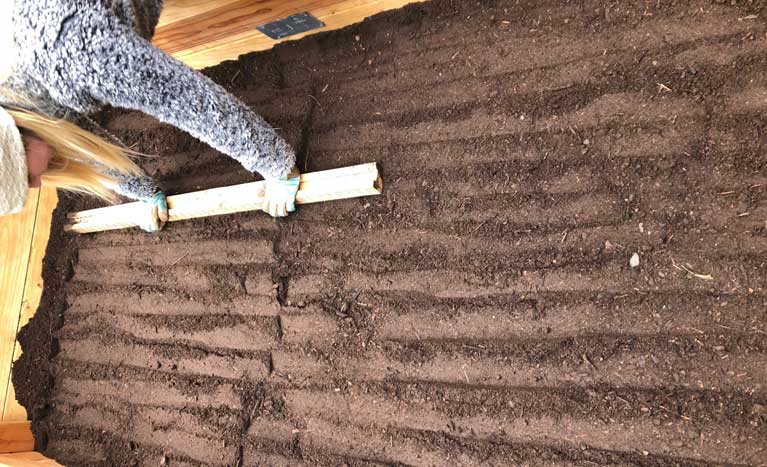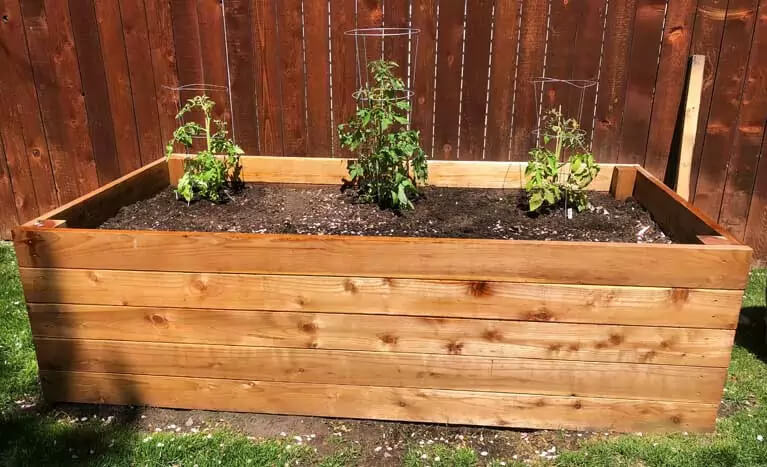So you built a raised garden bed and now you’re wondering how the heck to fill it!
Not only did you build an easy raised garden bed, but you followed my instructions on how to build a DIY raised garden bed, so the dimensions are: 8ft long by 4ft wide x 28in tall garden bed—pretty dang big!
Back in the day, my homesteading forebears couldn’t run to Home Depot for lumber—so they scavenged supplies from the land. I can only imagine spending days scouting for suitable wood, figuring out how to haul it back to the homestead, and then crafting a planter without electric tools. I cheated and used an electric screw gun to build mine! My great grandma would laugh at me for using modern day tools.
Did they even use wood to enclose their gardens?
Since there is always the need to protect garden crops from animals, they must have enclosed it somehow. They had fences made of scavenged posts and I think there was a rudimentary enclosure around the garden.
I built my raised planter with the intention of creating a sustainable garden to produce more of my food and decrease my dependency on local grocery stores, which are incredibly fragile and can collapse on a moment’s notice (as we learned in the recent pandemic.)
Beginning gardening is a bit daunting because it’s a brand-new skill for me. Whenever I doubt myself, I think of my homestead roots and my ancestors, who sustained a family of twelve children year around—and in a VERY desolate place!
Here’s a family snapshot of the barren land around the homestead:
No DIY garden centers on that horizon!
I’m beginning my journey by setting goals for myself. My ultimate goal is to be 100% self-sufficient and survive each year using my garden’s yield. I will can the fruits of my garden and create a serious emergency supply to last years. The first item on my Homestead Action Plan is to build a raised garden bed, and that’s DONE.
The second goal is to fill the raised garden bed. Surprisingly, filling the garden bed with soil is more difficult than actually building it. It’s long, deep, and wide so it’s quite the task!
While researching how best to fill a raised garden, I discovered that filling it entirely with garden soil is unnecessary and expensive! I tried to envision what my great-grandparents filled their garden beds with. From the looks of the photo, they certainly needed to enrich that soil. They probably created compost and cultivated their own garden soil. I haven’t started composting yet, but it’s on my Homestead Action Plan. I have no chickens or cows to utilize their products in my garden soil but I will research how best to create quality compost soil using alternatives to those basic resources.
In the case of my garden planter, I learned that placing organic material under the growing soil—even logs or leaves—is best! They break down over time and provide nutrients to the garden. With logs under the bed, I would need fewer cubic yards of soil. Bulk garden soil comes in “yards” so I used an online cubic yard calculator to size my order. I would use 1 yard less and save $70-$100 in soil cost by adding organic material in the bottom. The roots of my garden plants won’t even dip down that far, so it’s a win and much easier to fill my planter!
I foraged the woods for logs and placed them in the planter. On top of those, I dumped in all the fallen leaves from my yard. I don’t have a liner on the bottom of my planter, so worms and other garden friends can crawl up and feed the soil.
I used a common mixture called “Mel’s Mix,” which has a similar commercial version on Amazon.
You can easily create your own “Mel’s Mix” garden soil with the same ingredients: 1/3 blended garden compost, 1/3 peat moss and 1/3 coarse vermiculite. This perfect combination helps conserve water, feed plants, and keeps everything simple. This year, I bought a pre-mixed organic Mel’s Mix from a local garden supplier. I sometimes wonder what gardening magic my great grandparents used to sustain their homestead year around.

Although my gardening methods are different than those of my homesteading kin, I’m slowly learning and I hope to uncover their secrets through digging through old books and photos. Who knows what bits of treasure I might find. Maybe they’re somewhere watching me right now and chuckling at the process I used to fill my garden bed. I’m incredibly happy with my garden so far, and I can’t wait to see the yields.

